Top 20 Most Interesting Plants of the World
I had some success with my article about the world’s ten most interesting animals, so I decided I should do plants too. After all, plants have a reputation for being motionless and boring, but many of them are neither. These 20 plants challenge the mundane stereotype that plagues their kingdom. (Okay, technically some are fungi, so I cheated a little.) Hope you enjoy!
1. Corpse Flower, Titan Arum
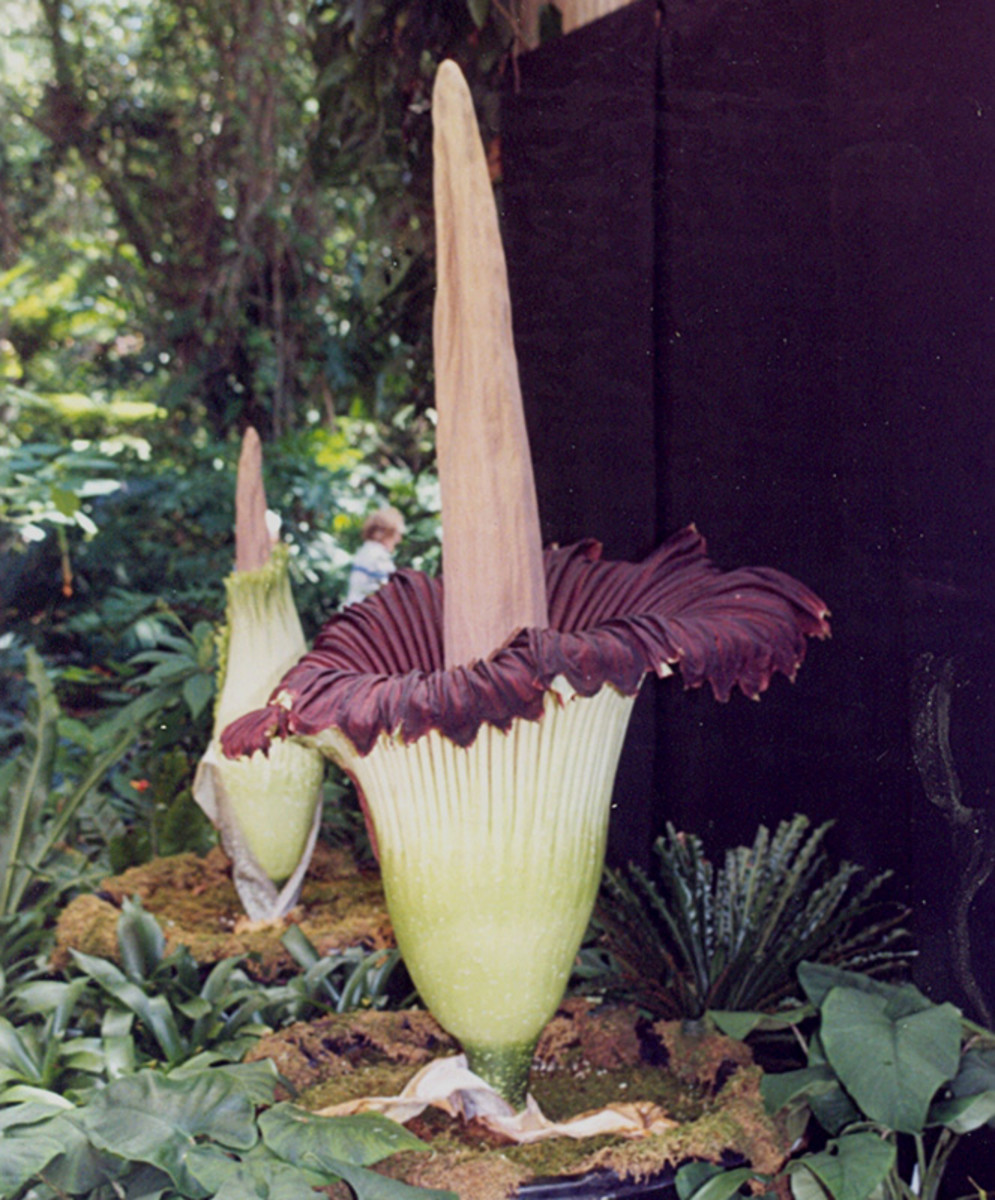
Not only is it ugly, it smells like a corpse. Luckily only 28 have bloomed in the United States. | Source
Amorphophallus titanum
The Corpse Flower smells strongly like a rotting corpse, and it looks like it belongs in the movie Avatar. I would imagine that the smell helps prevent it from being eaten, but despite this the plant is still very rare; according to the IUCN it’s officially “threatened." It comes from the forests of Sumatra. It's not actually one big flower; it’s thousands upon thousands of little male and female flowers. These exude oils, while the center collects heat. The heat plus the oils create the smell that attracts the beetles that pollinate the flower. In case you were wondering, a mature plant can weigh 200 pounds.
2. Elephant-Foot Yam
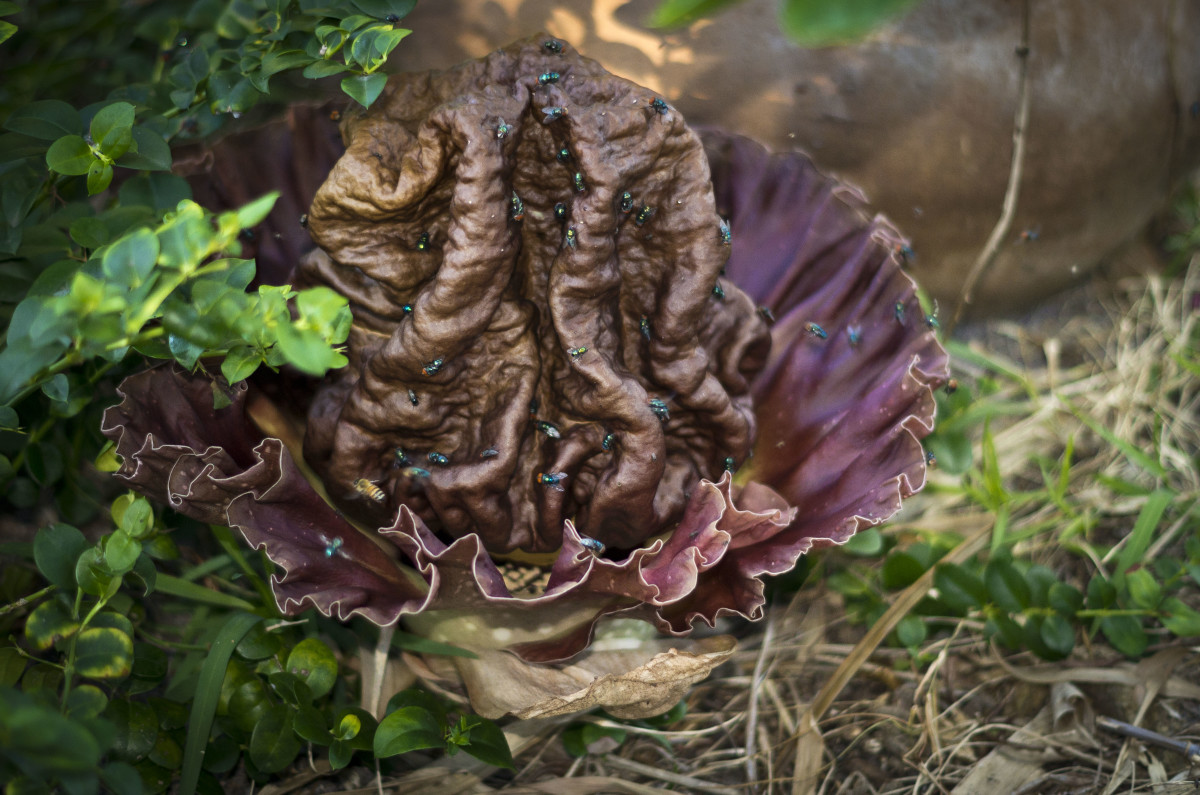
Amorphophallus (Elephant-Foot Yam) with flies | Source
Amorphophallus paeoniifolius
Guess who this cute little guy is related to? Yep, the Corpse Flower. Not only are they related, they also share many characteristics. For example this guy also smells like a corpse. These elephant-foot yams vary in color, as well. Some are pure white.
The Elephant-Foot Yam might have the edge on the Corpse Flower in wackiness because it is edible. In one Southeast Asian culture they are grown as a delicacy, while in another they are a last-resort food source.
3. Rafflesia: Another "Corpse Flower"
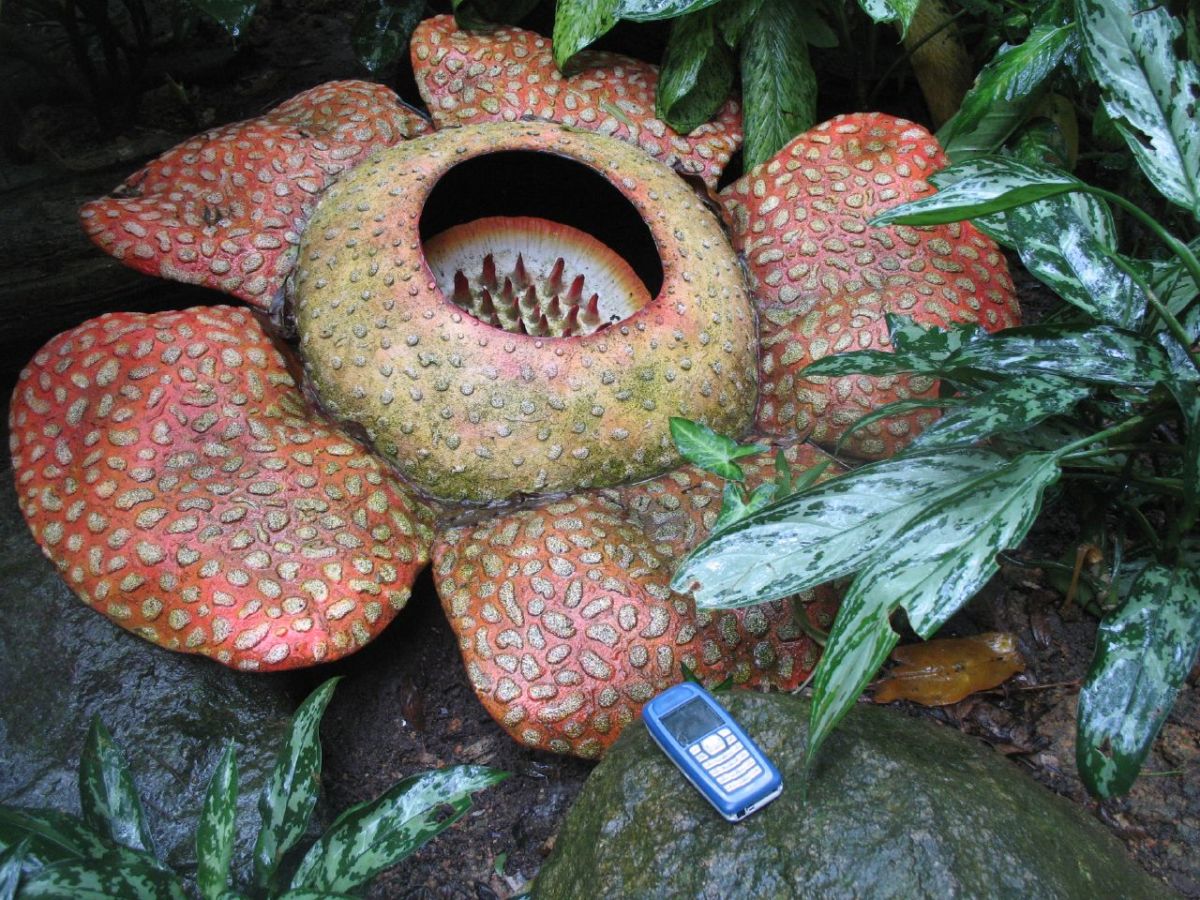
Rafflesia arnoldii, the world's biggest flower | Source
Rafflesia arnoldii
Rafflesia is another "corpse flower" because of its stench (I promise this is the last plant here that smells like a corpse). It's unique in that it is the world’s largest single flower. It is also wacky because it has no stems, leaves, or roots, though it does seem to be a plant of some kind. Some think it’s related to fungi. The Kew Botanical Gardens website puts it in Class Equisetopsia, related to horsetails, but Wikipedia puts in Malphigiales (a large category including willows and flaxes).
Want to find one so you can plant it in your backyard? Me too. However these are extremely hard to find. They live most of their lives as inconspicuous strands of tissue, parasitic on Tetrastigma vines in tropical rainforests, until the strands develop a little inconspicuous bud, which for a few brief days explosively transforms into the thing above.
4. Venus Flytrap
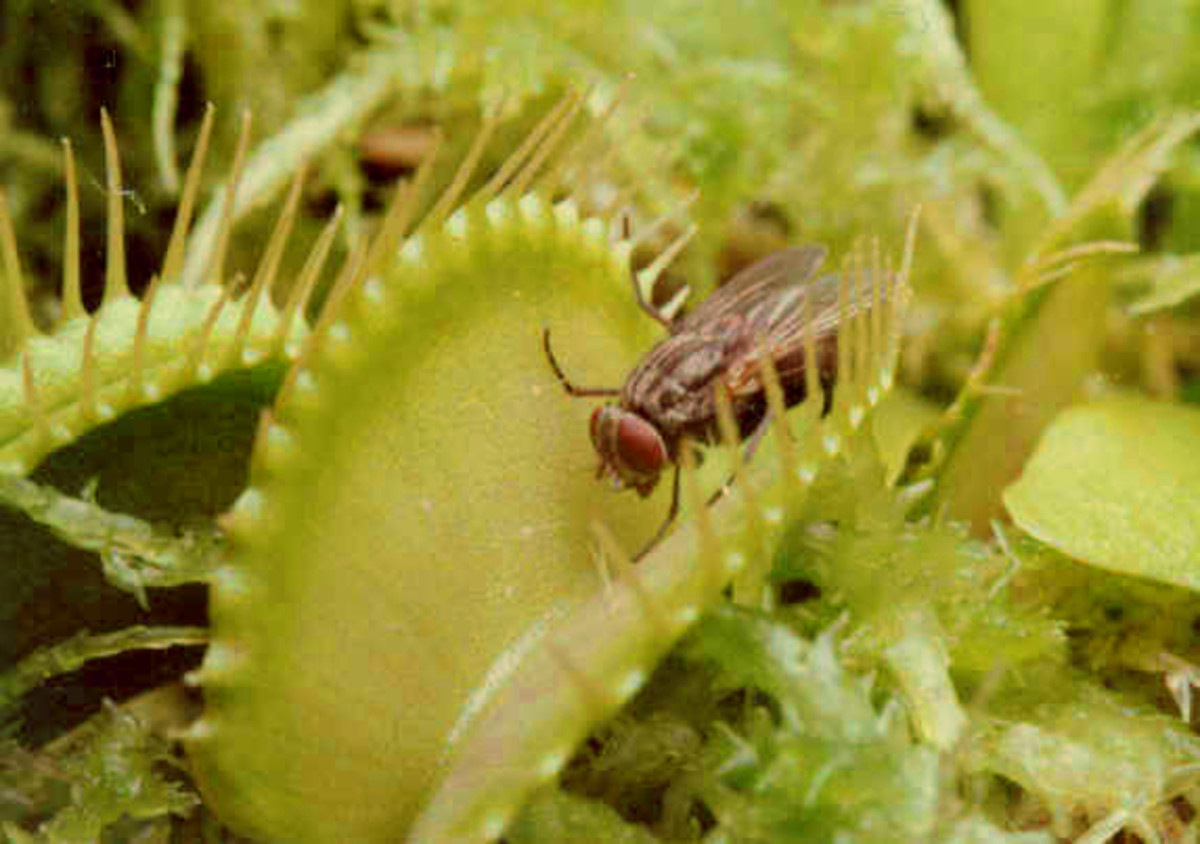
Flies, will you ever learn? Do NOT go near the plant with jaws! | Source
Dionaea muscipula
It's carnivorous. Not many plants eat things other than sunlight (though you'll see a few in the list below). And even fewer (about four species) are capable of rapid movement. This makes the Venus Flytrap seem like, I don't know, it might be from another planet or something. Actually it’s from boggy areas of North and South Carolina, where the soil is poor in nutrients. It craves a high-nitrogen snack once in a while.
You might wonder how the trap is triggered. Well, with trigger hairs. When two hairs are touched within 20 seconds of each other, or if a single hair is touched twice, the trap snaps shut. Healthier Venus Flytraps close quicker. Scientists are unsure about the mechanism; it has to do with neighboring cells sending chemical messages to each other.
The jaw-looking things act like interlocking fingers, or to the insect inside, prison bars. They do their best to restrain the insect from escaping. Then the rest is done with digestive juices. Read even more about Venus Flytraps from the Botanical Society of America.
5. Tropical Pitcher Plants
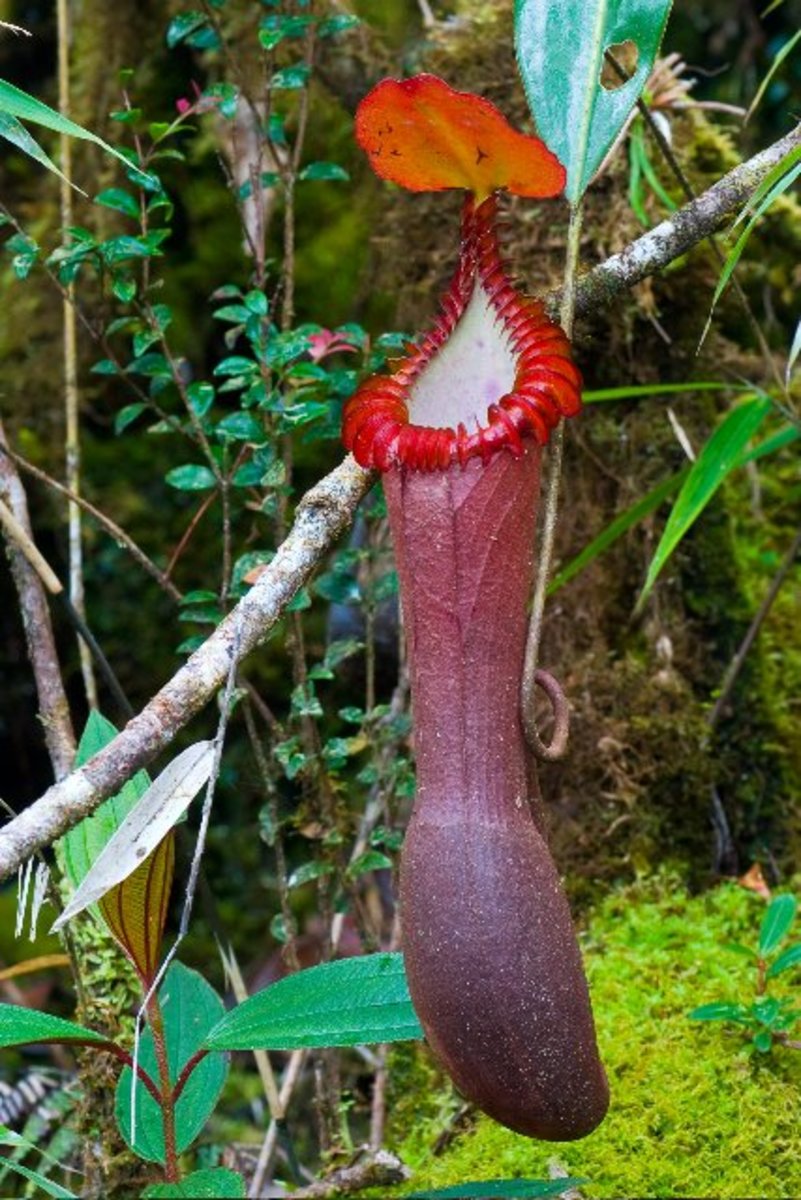
Nepenthese edwardsiana | Source
Nepenthes species
What is it? Monkeys have been spotted drinking from it. Rats have been spotted partially digested in it, and some other stuff too (no, it doesn't smell like a corpse). About 150 species are known, mostly from the forests of Sumatra, Borneo, and the Philippines.
The diet of a tropical pitcher plant includes just about anything that can fit into its pouch of sticky sap, including lizards, termites, spiders, and worms, though it seems to prefer smaller insects. The individual species have complex relationships with their ecosystems. One has evolved to host colonies of carpenter ants to clean up the leftovers from the larger carcasses, which if left lying around in the plant would lead to putrid conditions (we wouldn't want that). Some Nepenthes have evolved into toilet bowls for tree shrews, providing a shrew-sized perch and sweet exudate to attract shrews while they do their business. These plants get the bulk of their nitrogen from the tree-shrew dung they collect. Sound like I'm making this all up? I'm not.
6. Cape Sundew
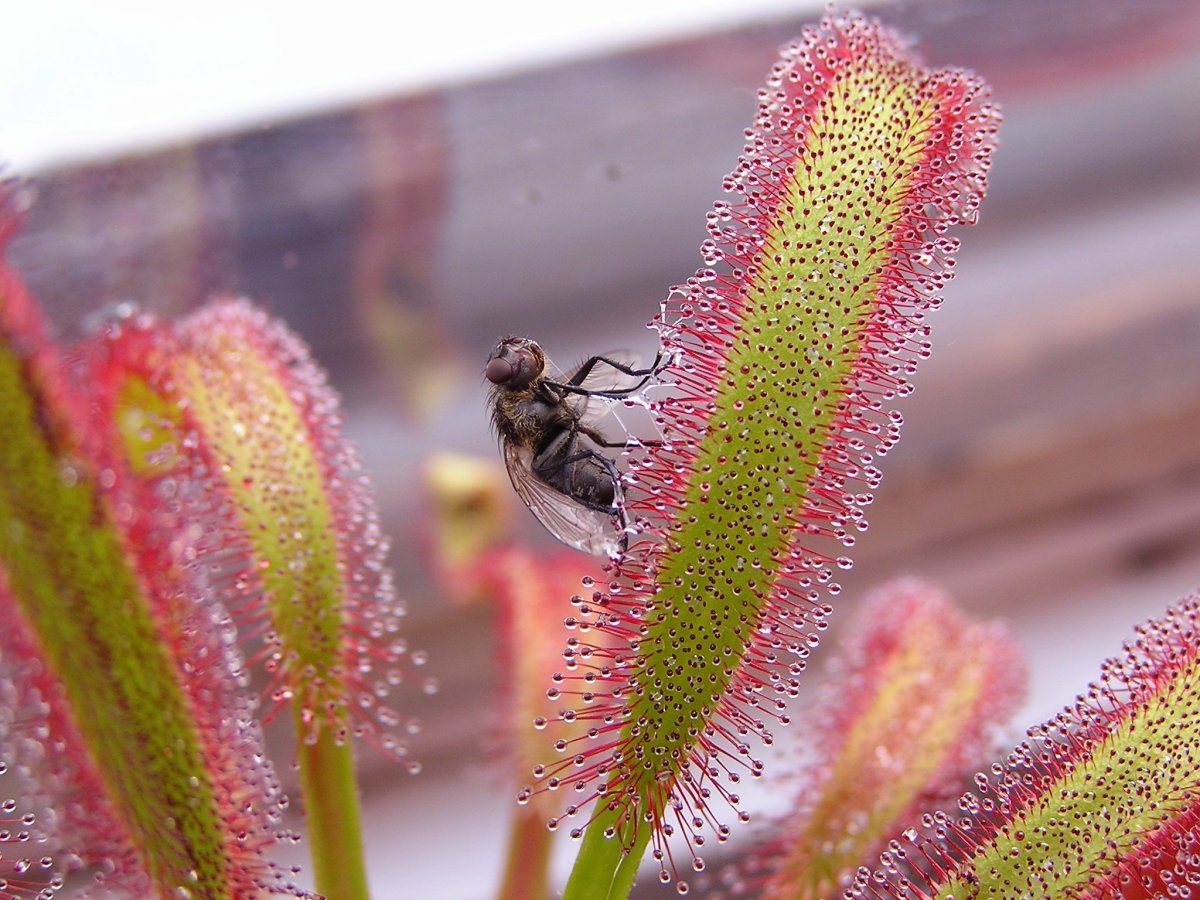
Another carnivore | Source
Drosera capensis
There are more carnivorous plants out there than you probably realized (more than I realized, anyway). The Cape Sundew, native to South Africa, traps insects not with rapid movements or weird pitcher-shaped appendages, but instead by slowly wrapping its “arms” (its sticky, sap-covered leaves) around its prey. This is slow, on the average about 30 minutes, and probably fairly cruel.
This is also the first plant on the list that is very good at reproducing. It reseeds easily and can survive a wide range of temperatures. It is on New Zealand’s list of invasive plant pests.
7. Strangler Fig
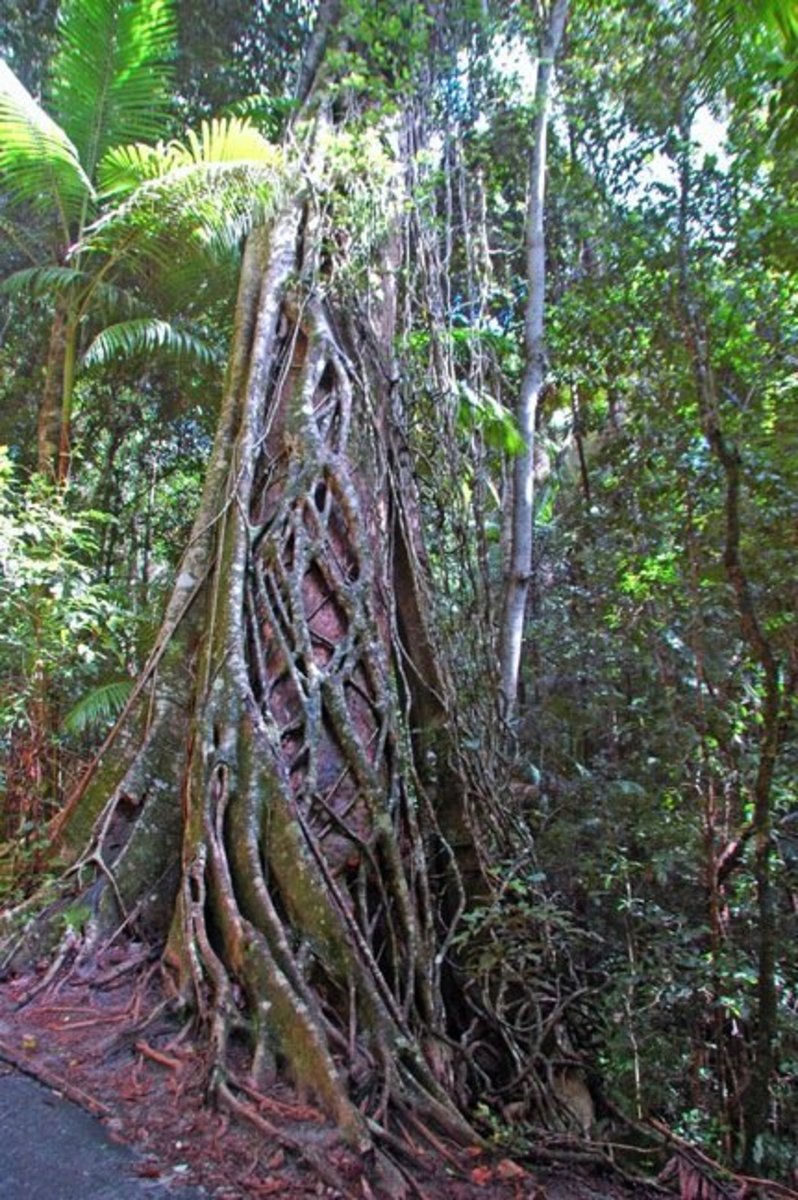
Strangler Fig, probably the biggest asshole plant on Earth | Source
Ficus (several tropical and subtropical species)
The Strangler Fig is the biggest mooch of the plant kingdom. Not only does it mooch, it kills. There are many different species of Strangler Fig, but they all are basically the same thing: that roommate who steals all of your food. Or that guy at a party who steals all of your beer. Or that guy in class who copied your homework and got a better grade. Only he kills you (could be a her, I'm not sure). Anyway, they are dispersed usually by hitch-hiking on birds and being dropped on the canopy of trees of a dense forest. They are wacky because they will grow up and down. Down so their roots can rob the living tree of all its nutrients, and up for sunlight. They often outlive the host tree by years, sometimes forming hollow cores that house the spirit of the old tree.
8. Bear's-Head Tooth Mushroom
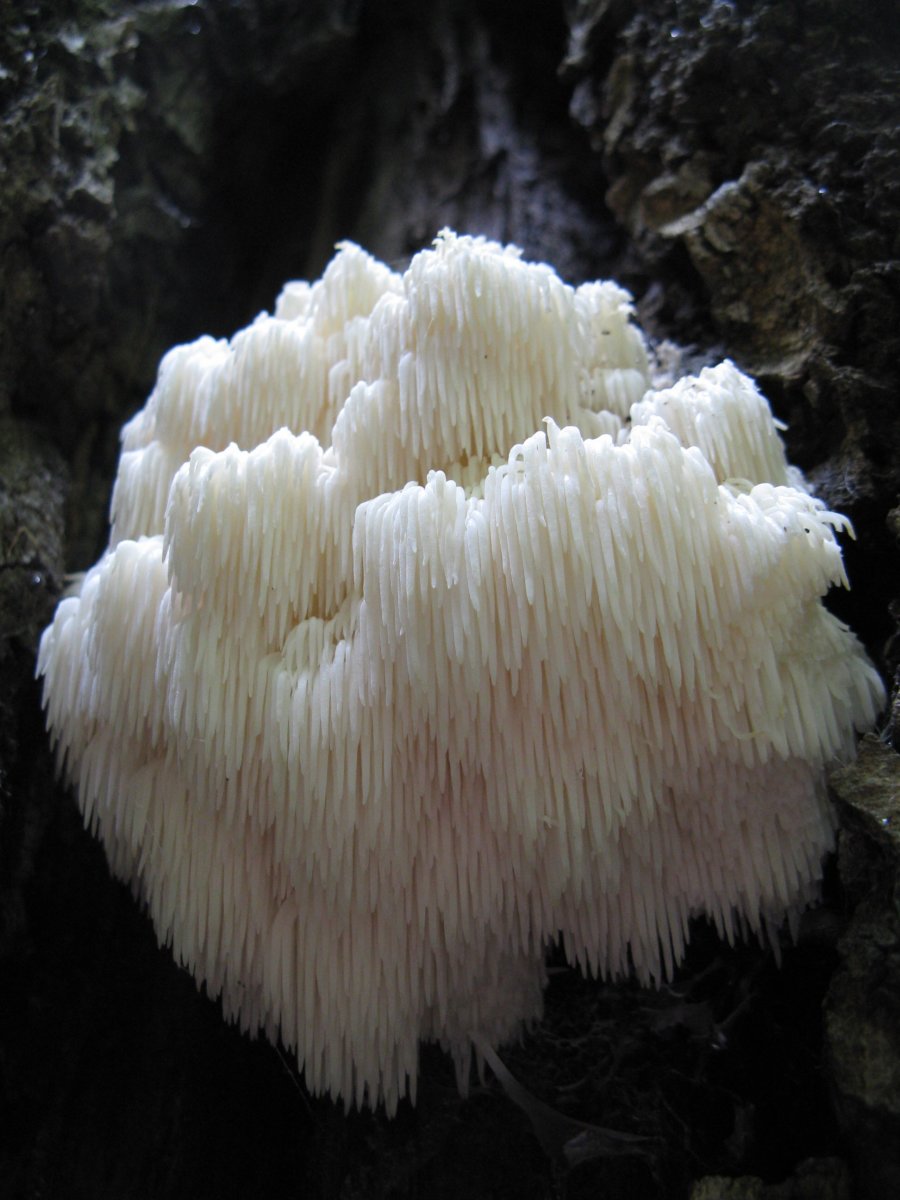
The creativity of Mother Nature... | Source
Hericium americanum
Well just look at it. That's a mushroom. If you're not convinced that it should be on this list ... it also fights cancer, stimulates nerve growth, and helps kill roundworms. How do we know? Well some really brave soul found out it was edible. Cydro still wouldn't put it on his sandwiches no matter what it does.
Oh yeah, it can grow branches too. I'm not sure how they came up with the name Bear's-Head Tooth Mushroom though. Looks more like a brand new mop to me.
9: Witches' Butter
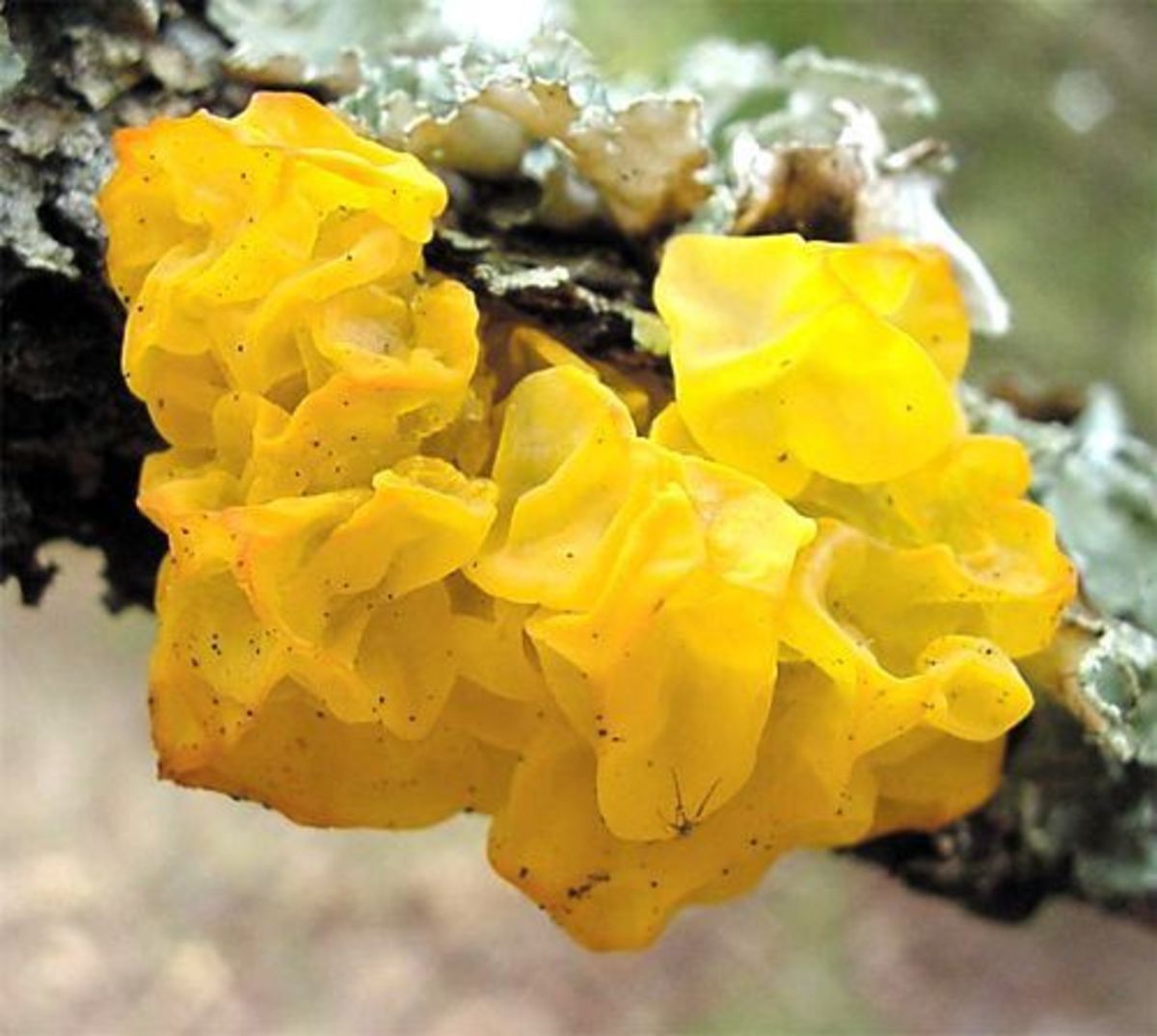
It must have been a triple dog dare to make the first person eat that. | Source
Tremella mesenterica
Sticking with edible fungi that look inedible, here is Witches' Butter. It has been given other pleasant names such as yellow brain and golden jelly fungus.
Well, I thought it looked funny. It also reproduces by both sexual and asexual production. If you do happen to try to eat it, you'll find that it has no flavor. Witches' butter is currently being studied because of unique biological processes that it undergoes. Some believe that they will prove to have health benefits. It grows on recently fallen and dead trees. It’s parasitic on other fungi, a nice niche.
10: Hammer Orchid
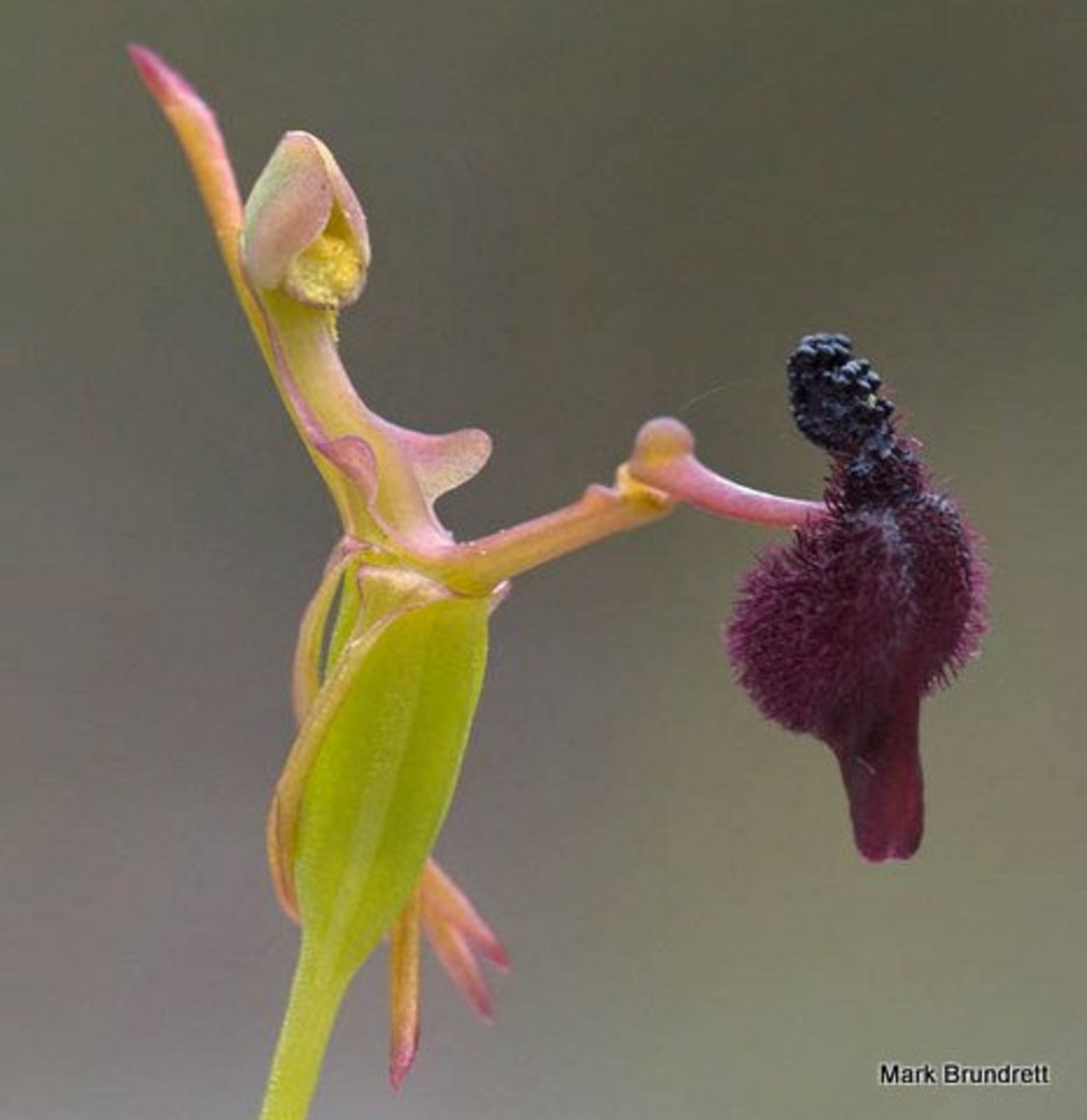
Basically a wasp sex toy | Source
Drakaea glyptodon
This endangered orchid from western Australia gets pollinated in a unique way. Does that red thing on the side look like it belongs there? And what's that black thing on top of the red thing? Well, you'll find this appendage on all of the Drakaea glyptodon that you come across.
Female thynnid wasps happen to be flightless. They also happen to climb on top of plants to signal to the male wasps, who can fly. The male picks them up and does his thing to reproduce with them during flight. The Drakaea glyptodon mimicks the female thynnid wasp's body. The male wasp, being a dumb horny guy, tries to pick up the fake female wasp and instead gets pitched into a mass of pollen. To actually finish pollinating a plant and keep this orchid species going, he has to come in contact with yet another Drakea glyptodon and try to mate with it. So he has to be fooled twice. Now you know how they came up with which was the male and which was the female.
Also, the plant smells like "raw meat." It kind of looks like it, too.
11. Silver Torch Cactus
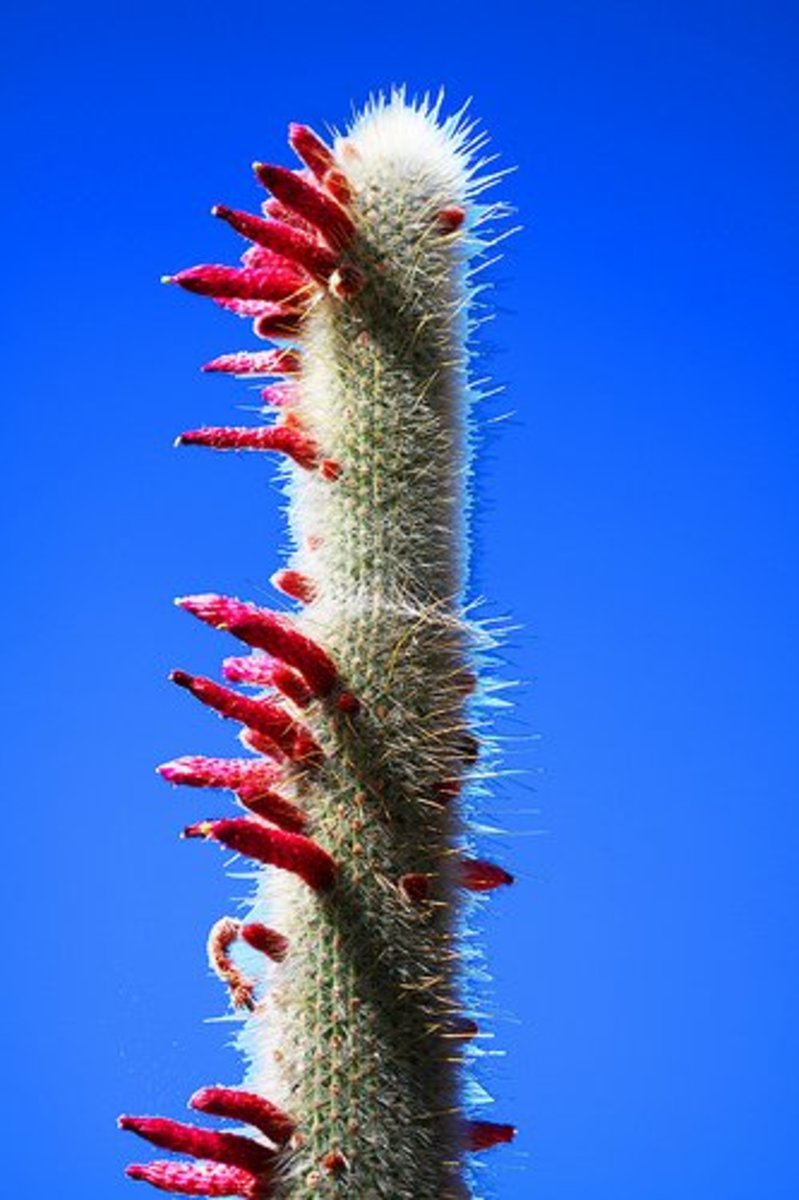
Uhem. What are those things? | Source
Cleistocactus strausii
The Silver Torch Cactus is wooly, but that isn't unusual; it grows flowers, but that isn't too unusual. Although the way the flowers are shaped is is unusual (yes those are flowers), other cacti bloom kind of like this, just not as horizontally.
But it does have a cool name, and it is a very unusual cactus in that it prefers cold temperatures. It lives in the high mountains of Bolivia and Argentina and can stand frosts of up to minus 10 degrees Celsius.
12. Dragon's-Blood Tree
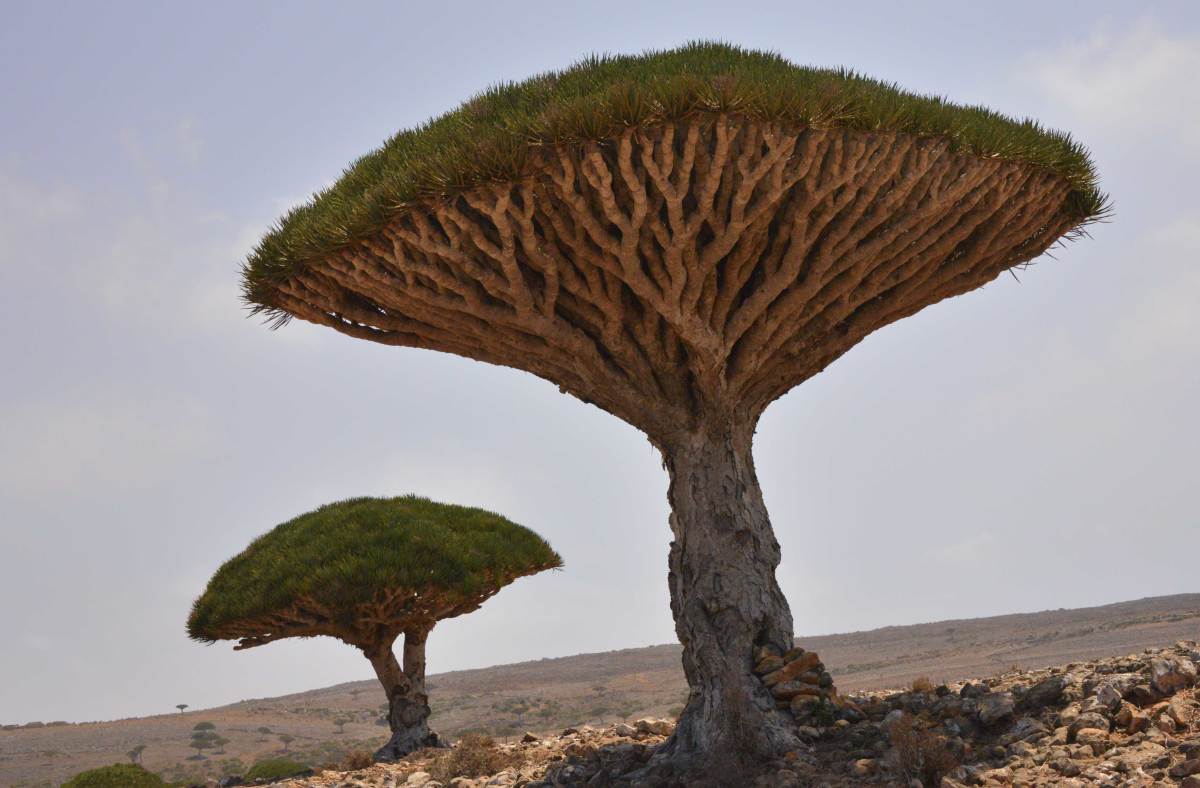
Looks like it should be in a dinosaur movie | Source
Dracaena cinnabari
Man, I wish I had a name like that. “The Dragon's-Blood Guy.” I can see it now. The Dragon's-Blood Tree is one of the coolest-looking trees ever. Its sap resembles dragons' blood; it’s a deep red, even when dried into resin. It was prized among the ancients. It can be used for stimulants, and for toothpaste, of all things. Luckily it survived thousands of years of everyone trying to collect it, which is saying a lot since it is only found on the island of Socotra. The species is a remnant of a subtropical forest ecosystem that used to stretch across North Africa until the desert took over there.
The canopy looks like an umbrella and acts like one; it shades the roots and reduces evaporation. The trees tend to bunch together, because the shade collects what slight dampness there is on Socotra (which gets 10 inches of rain a year) and helps seedlings grow.
13: Welwitschia
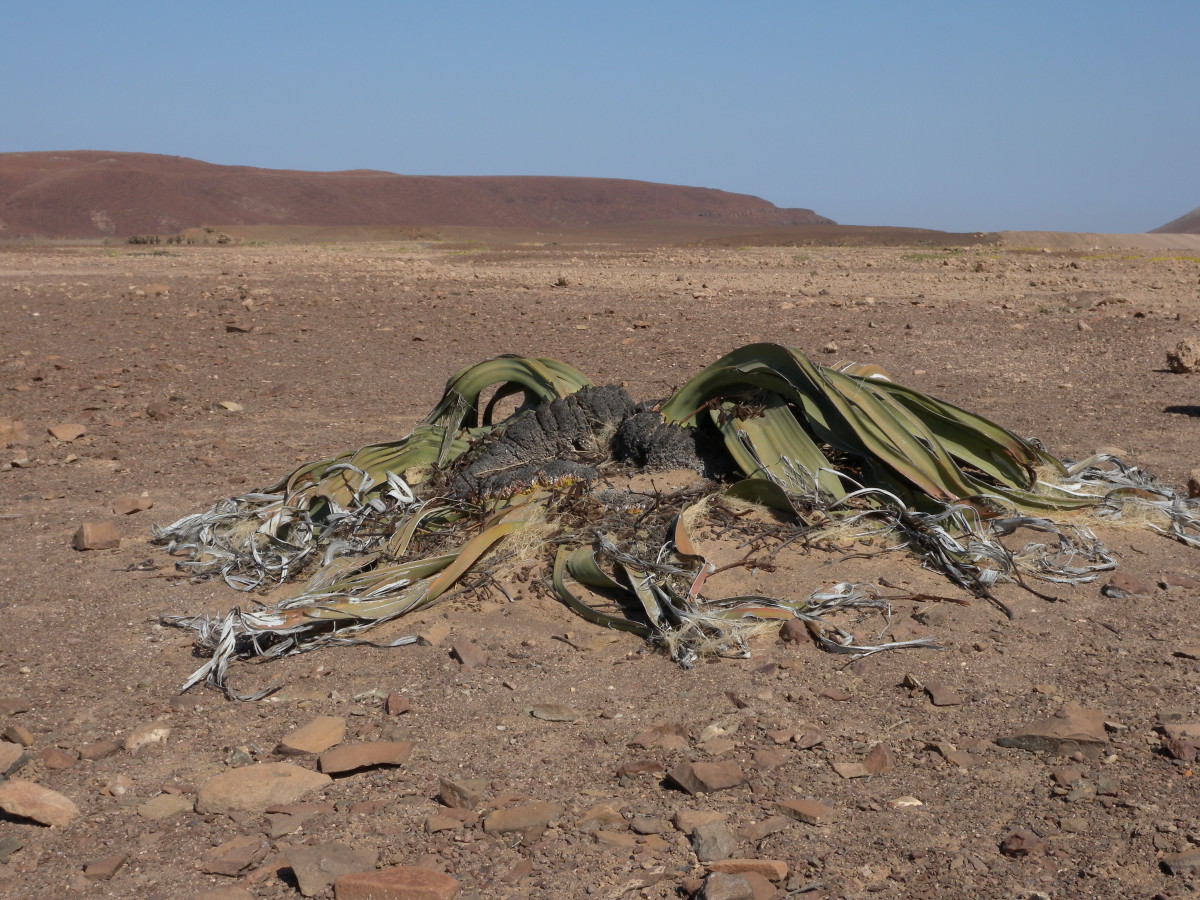
You wouldn't look much better if you were that old and spent your entire life in the desert.| Source
Welwitschia mirabilis
Also called “tumbo”and “tweeblaarkanniedood,” Welwitschia is a living fossil found in the deserts of Namibia and Angola. Its close relatives have gone extinct and its distant relatives include pines, spruces, larches, and firs. It has one very short trunk and two leaves—only two. It grows only two leaves no matter how mature it is.
Oh yeah, and carbon dating tells us they live from 400 to 1500 or even 2000 years! So the one above will probably be alive when your great-great-great grand kids are alive. That is assuming no apocalypses happen, although I'd bet these guys could get through an apocalypse much better than we could.
14. Hydnora
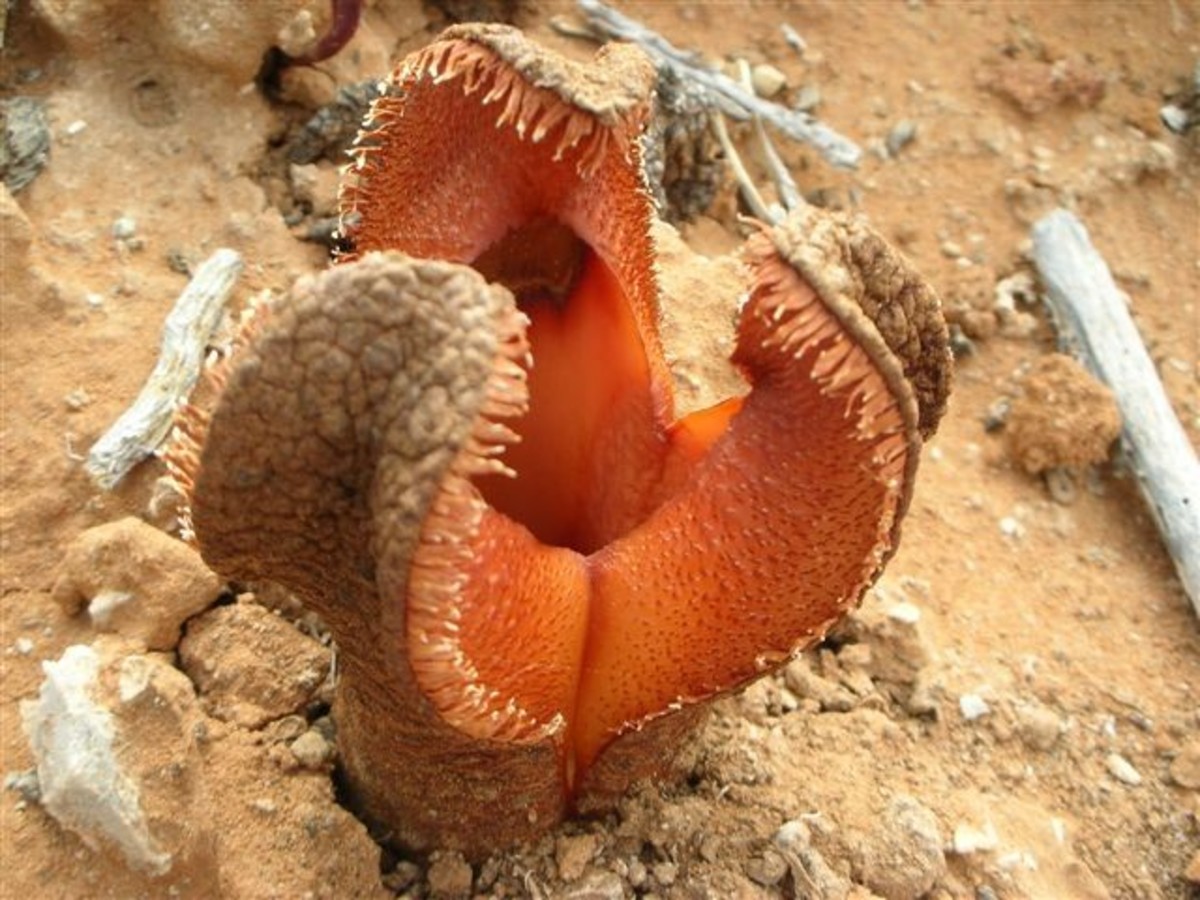
Kind of pretty, maybe? | Source
Hydnora africana
This plant looks like it might belong on a fictional planet in a sci-fi movie, except that no viewer would find it believable for a moment. The Hydnora grows completely underground except for the flower (“flower!”) which is shaped to maximize the efficiency of its bristles in directing beetles to its unpleasant center.
And why would beetles want to go near that? Well, because it smells like feces. Many an entranced dung beetle has been lured into its depths. I know what you’re thinking: Cydro, will you lay off with the carnivorous plants? Don't worry, it doesn't eat the beetles. It just keeps them. It traps them until the flower is completely mature, and then releases all the beetles to go forth into the world and pollinate and reproduce. The male and female Hydnoras have different receptors for this pollination, so the beetles have to come across another Hydnora for the scheme to work.
Does this lovely thing, once pollinated, bear fruit? Why, yes; the fruit takes two years to mature underground, is said to be similar in taste and texture to a potato, yet useful for tanning leather and preserving fishnets.
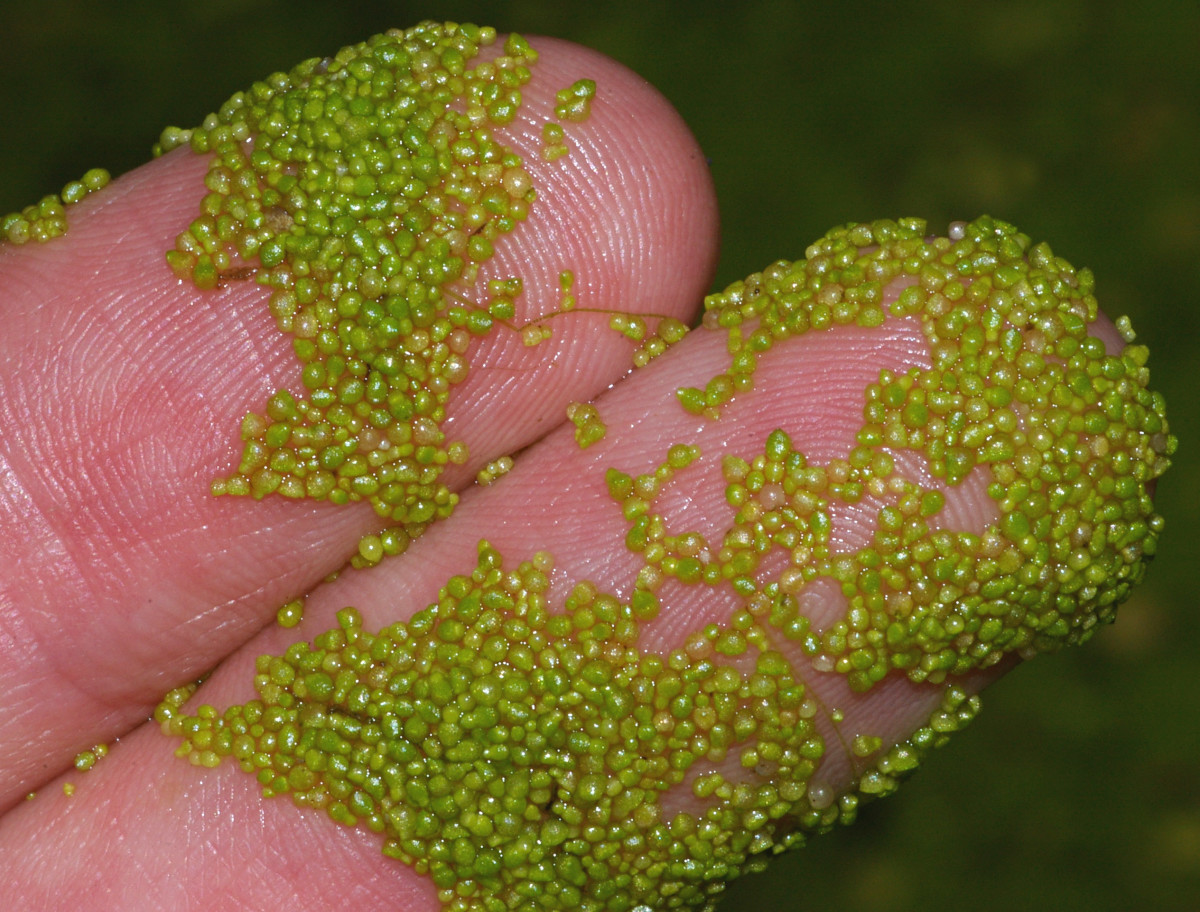
Wolffia arrhiza. Eeny weeny, aren't they? | Source
Wolffia species
Wow, they're small! In fact, they're the world's smallest flowering plant! How small are they? Well...
1. FInd an "o" on this page
2. Imagine two specks inside that "o." Two adult Wolffias could fit inside of that "o"! Also, if you looked back in 30-36 hours, there might be four of them! They reproduce really fast. One more thing: they don't have leaves, stems, or roots, though they sometimes sport a tiny flower with one stamen and one pistil.
If you've been to a pond or a river on any continent there's a decent chance you've encountered them, perhaps under the name "duckweed." Several Asian species are skimmed off the water and eaten, or fed to animals; they are 40% protein.
16. Lithops
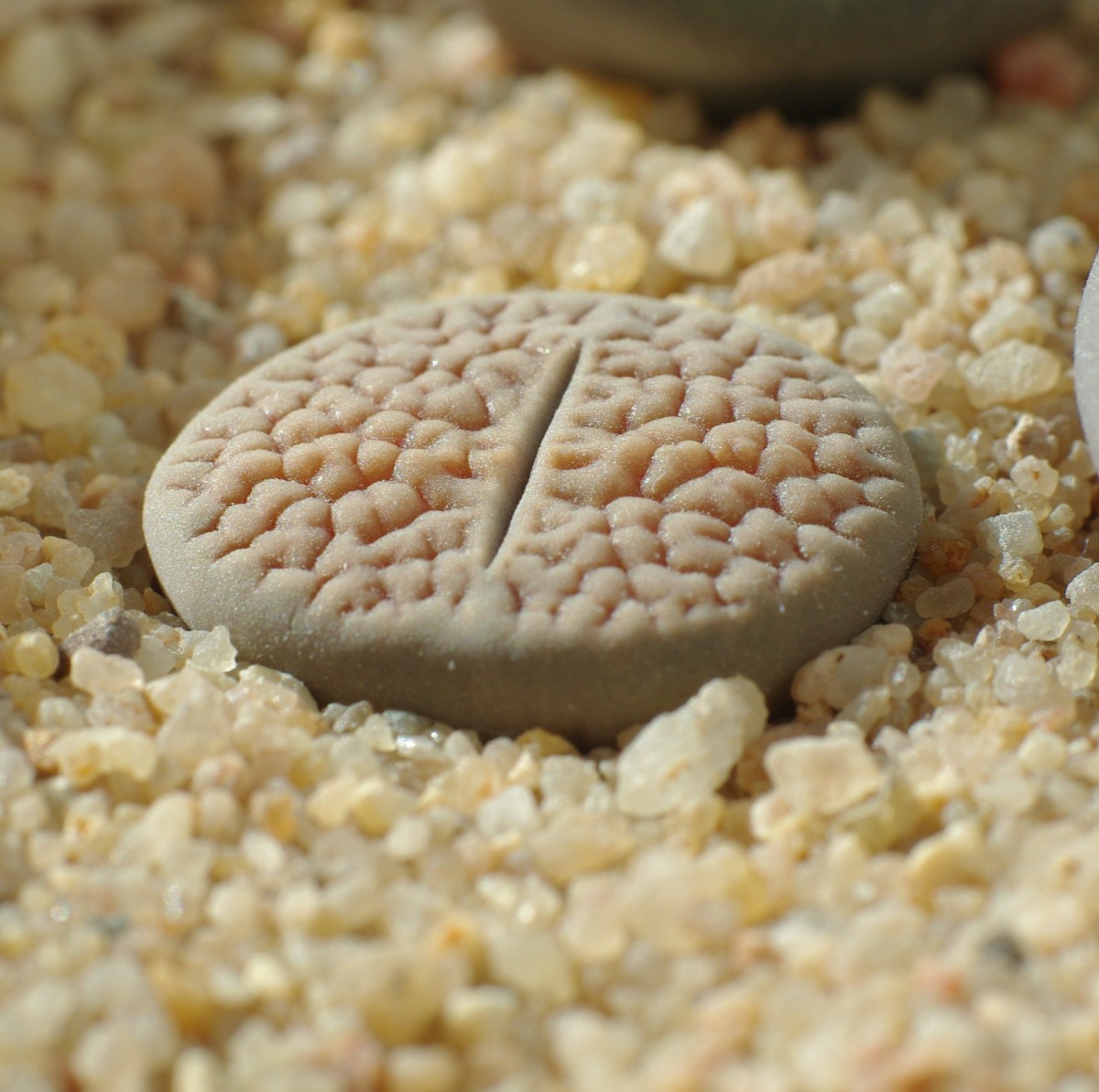
That's a plant? | Source
Lithops species
Some plants use toxins to avoid being eaten. Some use thorns. A Lithops survives by pretending to be a rock. If you're into picking up rocks in southern Africa, chances are you'll pick up one of these two-leafed plants. There are dozens of species, each generally preferring a certain type of rock to hide among. In a drought they may shrink down below the ground surface, using their translucent top coating to collect any light that filters through the gravel.
They are fun plants to grow, and if carefully tended, may reward you with a yellow or white daisy-like flower.
Awww ... Cute!
17. Victoria Amazonica
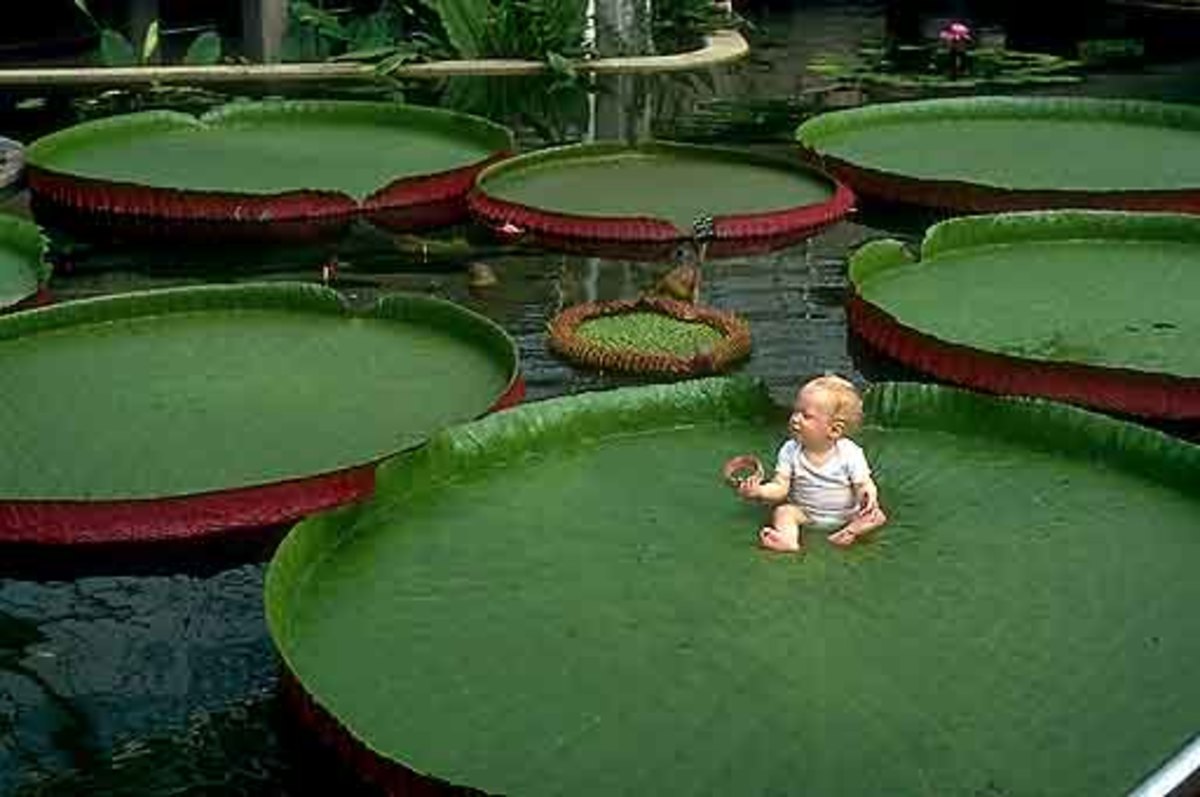
Who put that baby there!?!? | Source
Victoria amazonica
Kew Gardens, the Victorian plant museum, has a proud collection of these water lilies. The leaves grow up to three meters across! The edges bend up to avoid overlapping with their neighbors, and the undersides are thorny to protect against being eaten. A mature lily pad can support an evenly distributed load of 45 kilograms, or, apparently, a baby.
Their flowers are huge and beautiful, and can only be seen at night. On the first night, the flowers are white, female. and fragrant, and trap beetles inside themselves; on the second night they are pink, unscented, and male, and let the beetles loose, dusted with pollen, to seek a fragrant white female flower open for its own first night. If you see the flowers at daybreak, you can watch them close up rather quickly.
18. Dragon Arum
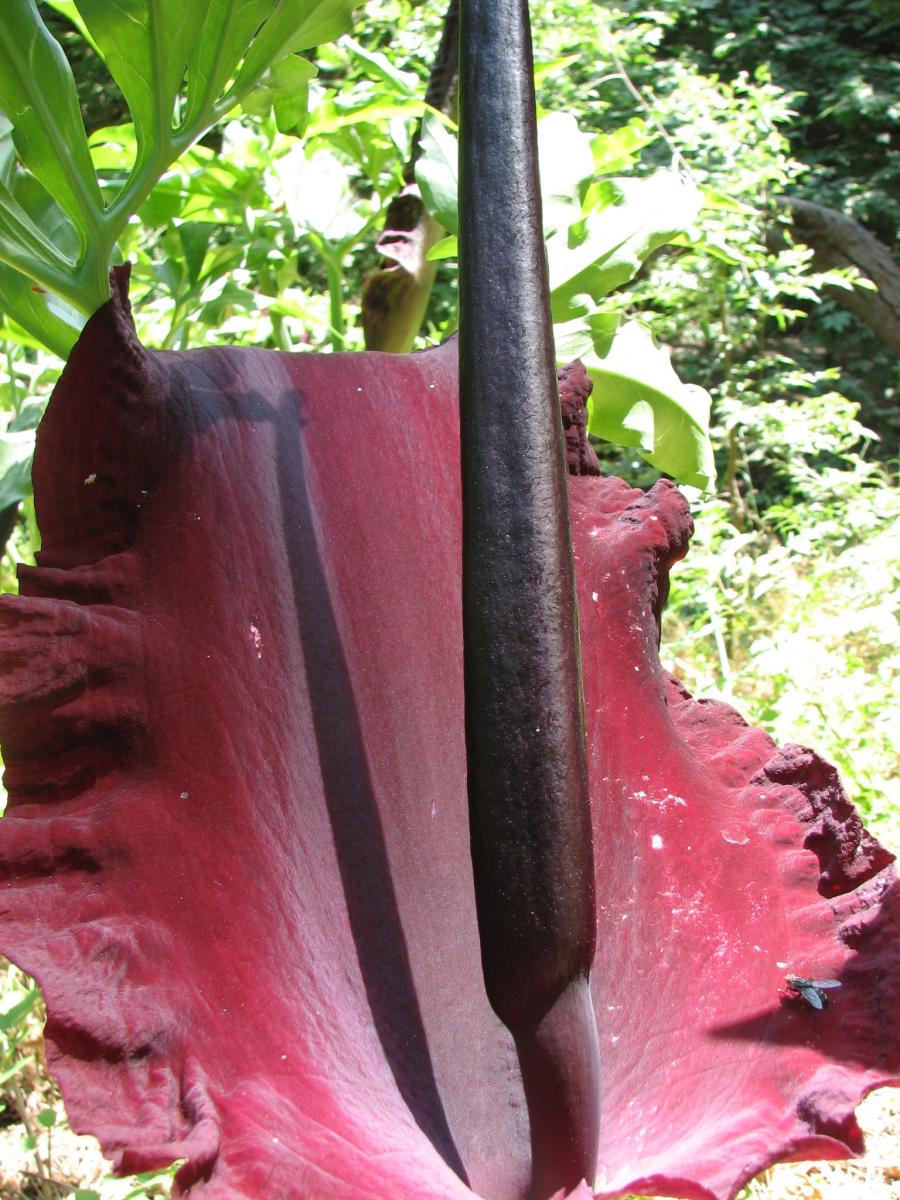
Source
Dracunculus vulgaris
I know I promised not to mention any more plants that smell like a corpse. But this yard-long flower-thingie only smells for a day, and it’s just a “a nauseous dungy rotten meaty odor,” so does that count? As you might guess, it smells in order to attract flies to pollinate it. This stinker is different because it is found in southern Europe, not Southeast Asia.
It is poisonous as well. So look, don't touch!
19. African Acacia
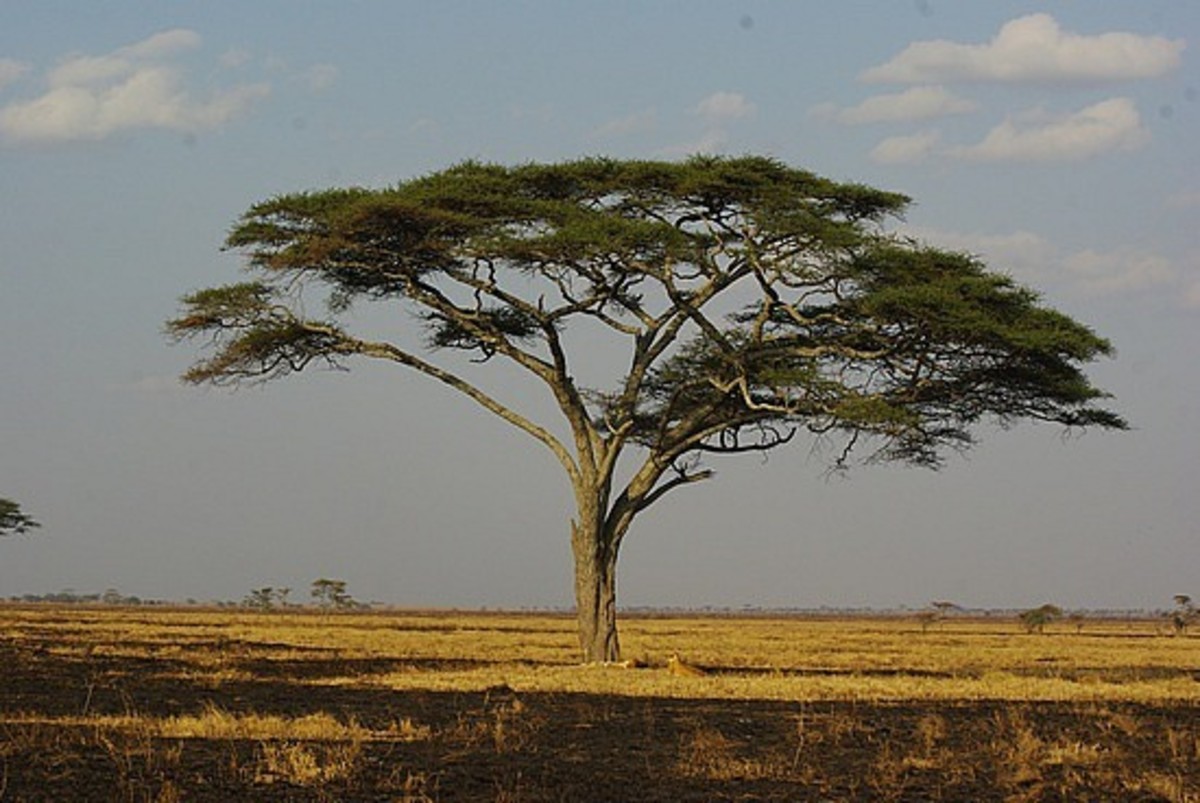
Looking innocent is the only thing it does better than killing herbivores.
Acacia (now Vachellia) species
An acacia on a plain looks so innocent, the classic image of the African savannah. I think I saw it on The Lion King. Well, the tree is a mass murderer. If an African Acacia tree is under attack by a grazing animal, say a kudu, it releases a cloud of ethylene gas, thus warning trees up to 50 yards downwind to produce extra tannin in their leaves, making them toxic.
Zoologist Wouter Van Hoven figured this out when he was asked to investigate the sudden death of some 3000 kudu antelope on game ranches in the Transvaal. Observing the grazing activity of animals in the area, he noticed that the giraffes, who were free to roam and pick the trees they ate, ate only certain acacia trees, about one out of ten, and avoided acacia trees that were downwind of others. The kudu, on the other hand, who were fenced in on game ranches, had little to eat in the winter but acacia leaves, and thus ate toxic leaves until they died. The trees killed the kudu by communicating with each other.
Besides using gas, toxins, and thorns to defend themselves, acacias often hire an army of ant bodyguards. The trees provide housing and nectar for the ant, and the biting ants attack whatever comes near the tree. The plant does need herbivores to help propagate it, however, so the ants can’t be too efficient in chasing away all grazers and pollinators. Thus acacias have some complicated three-way relationships.
20. Bladderwort
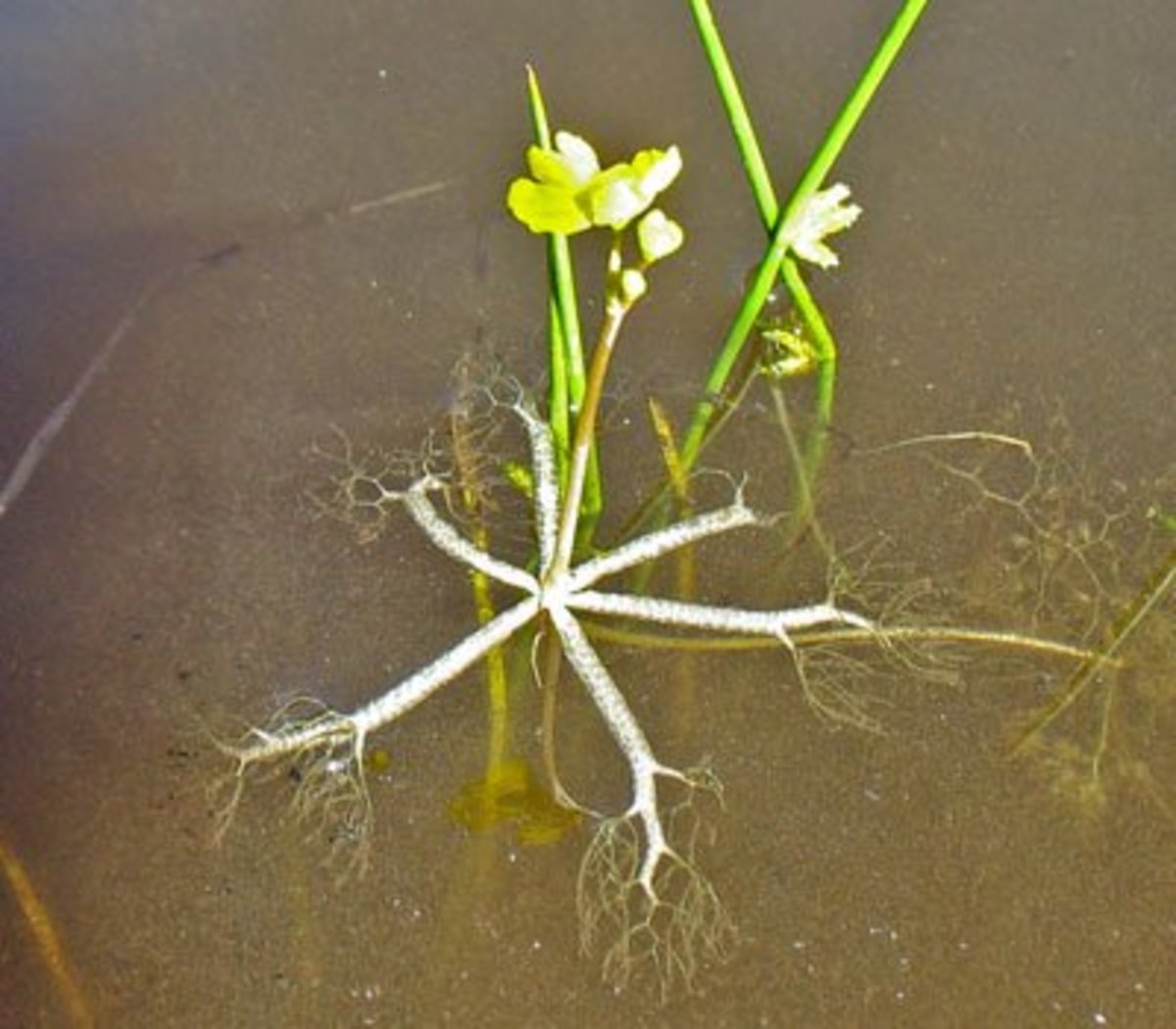
Source
Utricularia species
Bladderworts are found in tropical and temperate ponds all over the world. What makes them at all interesting? Well, they are submersible floating carnivores. They use little air sacs to float when they are blooming, and then when it's not blooming time they drift underwater like seasonal submarines.
They eat tiny little invertebrates that they suck into their bladders with a vacuum. Beat that, Venus Flytrap. Tiny fish have also been known to trigger the trap.
They are good at surviving just about anywhere (unlike most carnivorous plants). In some places in the United States they have become a pest and humans are trying to get rid of them.
What happens when one floats into the bank of a pond? Well, it will attach itself to the side by extending little needle-like stems. Who knew a plant could resemble a Swiss Army knife so much?
Bonus for Reading This Far! World's Largest and Oldest Trees
Check out a few record-breakers below.
World's Largest Single-Stem Tree: "General Sherman" Giant Sequoia
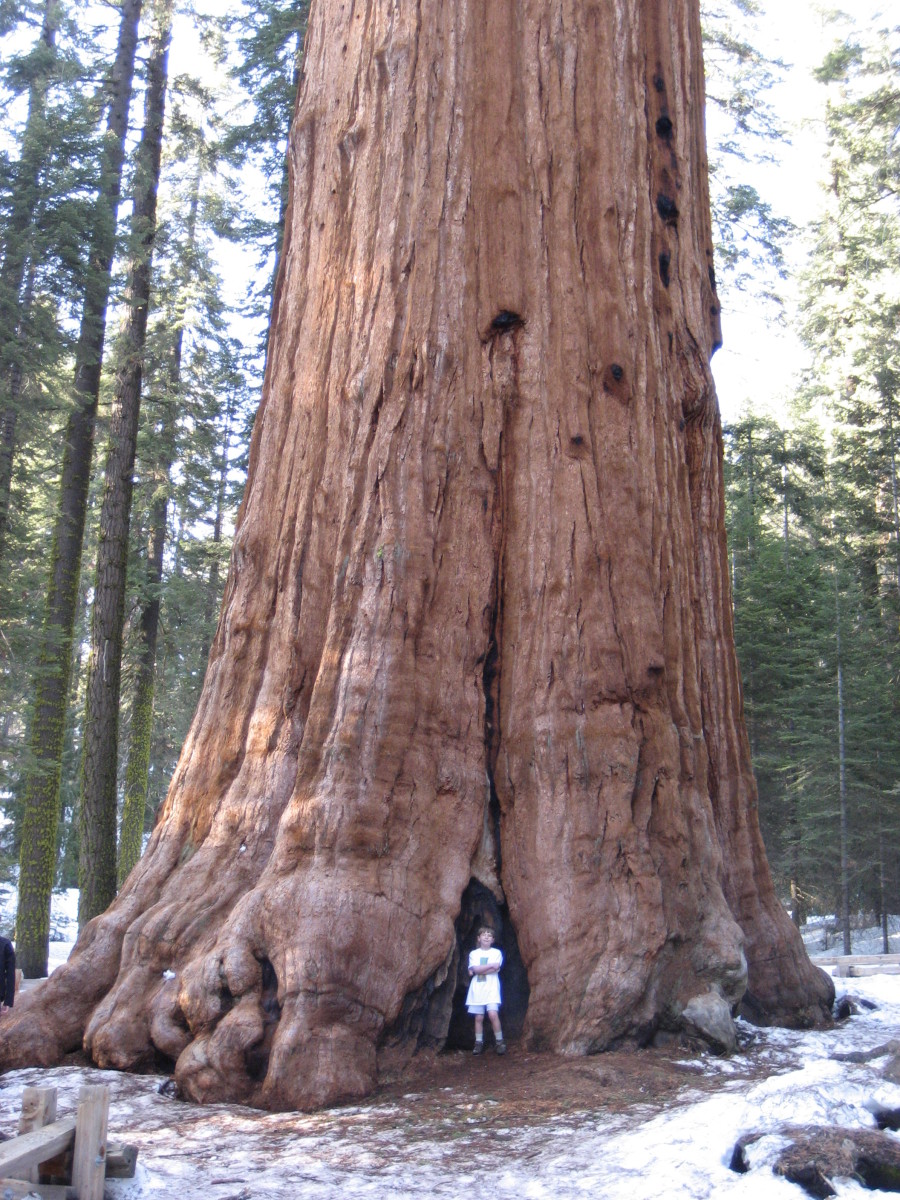
"General Sherman" tree | Source
Sequoiadendron giganteum
Not the tallest nor the broadest tree in the world, but the biggest living single tree in volume, the General Sherman tree is a giant sequoia 275 feet tall (almost the length of a football field). It weighs about 1,800 tons (3,600,000 pounds), and is wide enough that a school bus could be driven through its trunk. But it is much smaller than the largest tree ever recorded, a Coast Redwood (Sequoia sempervirens) that fell over in 1905 and weighed 3,300 tons. Wow! These trees, of course, have no natural predators.
World's Largest Tree By Area and Volume: Pando, the Quaking Aspen
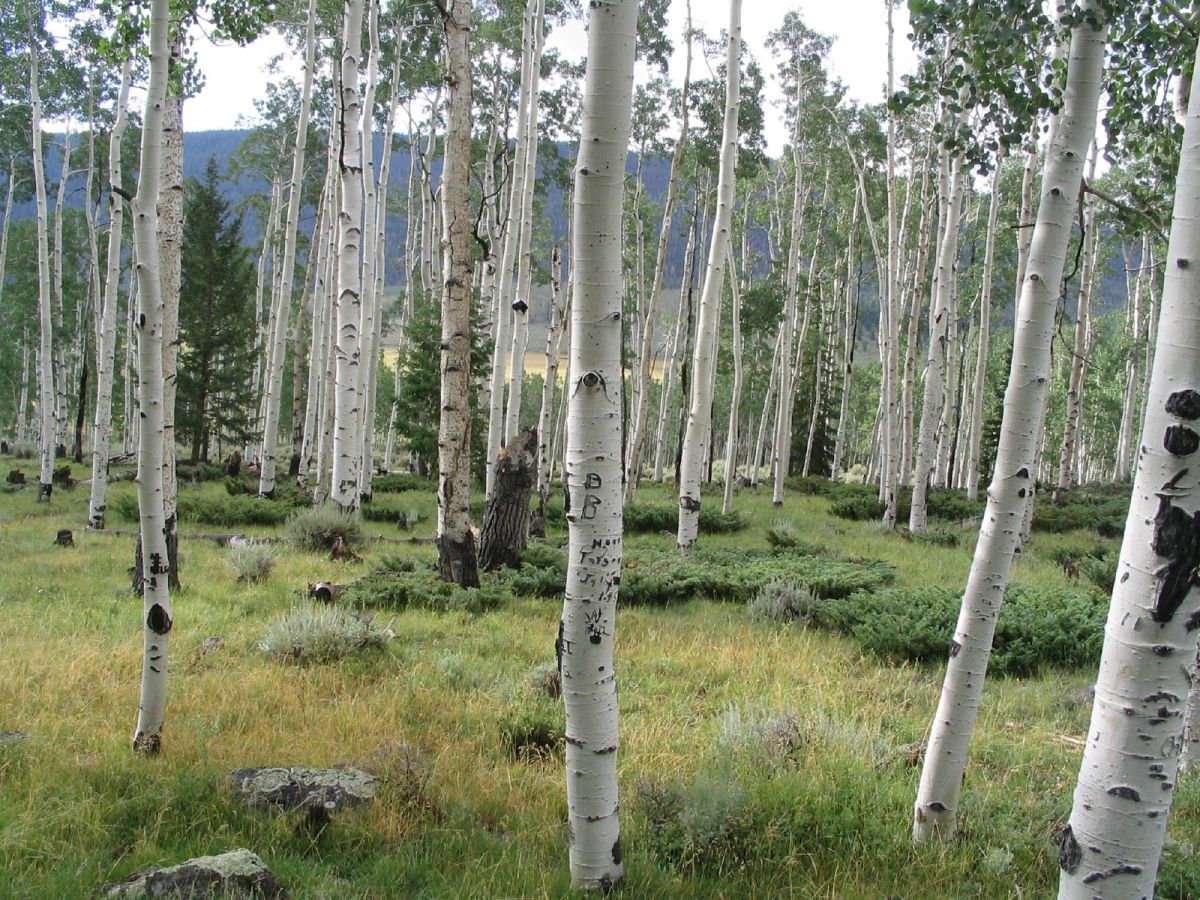
Fish Lake in Southern Utah. The Pando quaking aspen colony is within a mile of Fish Lake; these trunks may be part of Pando. | Source
Populus tremuloides
The Pando tree, an aspen in southern Utah with over 40,000 genetically identical trunks and a shared root system, covers an area of 106 acres, weighs almost 6000 tons, and is thought to be 80,000 years old, having survived multiple ice ages and fires.
King's Holly: An Ancient Sterile Clone
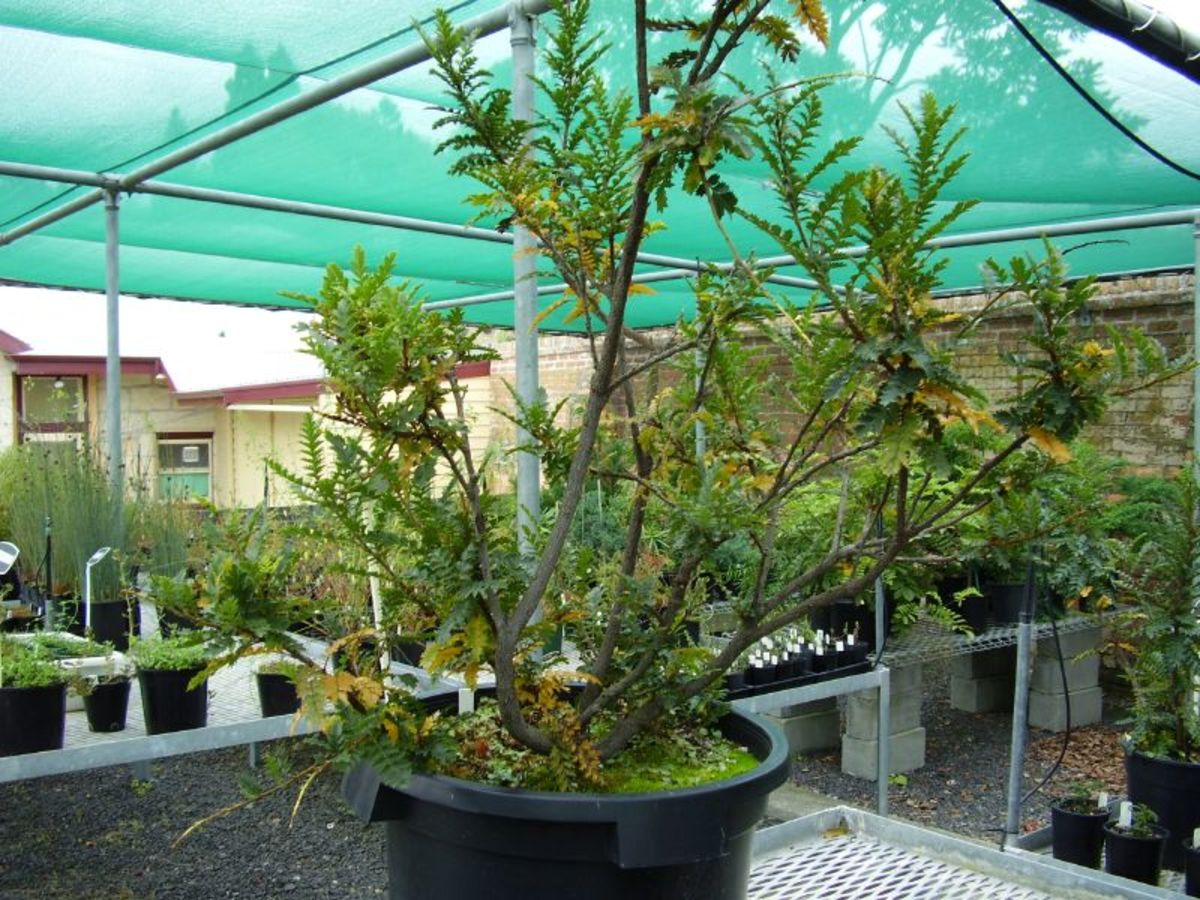
A cutting of King's Holly, growing in the Hobart Botanical Gardens | Source
Lomatia tasmanica
Not really a holly, but related to proteas and macadamia nuts, and named for a botanist named King. A single colony survives in the wild, 500 individuals in the southwest corner of Tasmania.
How old is the King's Holly plant? Take a deep breath and guess. 400 years? 4,000 years? 40,000 years?
At least 43,600 years, actually. It doesn't have a male or female part, or pollinate; it can't reproduce sexually because it has three sets of chromosomes. It survives by dropping its cloned branches on the ground until they grow. They carbon-dated a nearby fossil of the same plant, which they knew was a clone because of the rare triploid chromosome pattern, and found it to be 43,600 years old.

1 comment:
I am writing to you to avail myself of my rights under the Digital Millennium Copyright Act (DMCA). This letter is a Notice of Infringement as authorized in §512 of the U.S. Copyright Law.
1. The copyrighted work at issue is the text that appears on:
https://owlcation.com/stem/Strange-Ocean-Fish
2. The URLs where my copyrighted material is located include:
https://zoologyinaction.blogspot.com/2016/09/ugly-fish-and-weird-sea-creatures.html
3. My contact information is as follows:
Gable Rhoads
3619 Highway Ave
Highland, IN 46322
gcrhoads64@yahoo.com
4. I have a good faith belief that use of the copyrighted materials described above as allegedly infringing is not authorized by the copyright owner, its agent, or the law.
5. I swear, under penalty of perjury, that the information in the notification is accurate and that I am the copyright owner or am authorized to act on behalf of the owner of an exclusive right that is allegedly infringed.
Gable Rhoads
Post a Comment